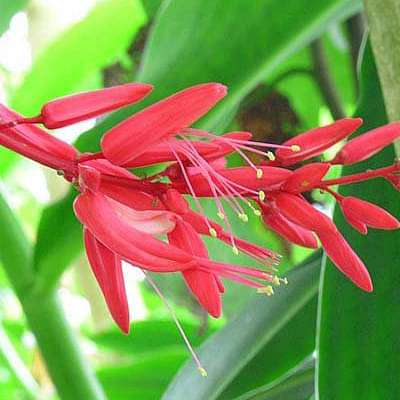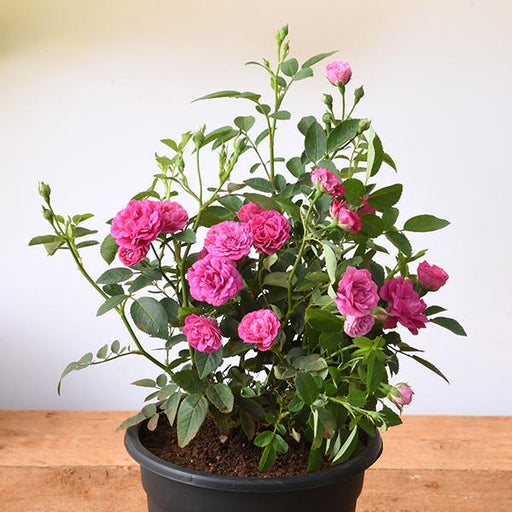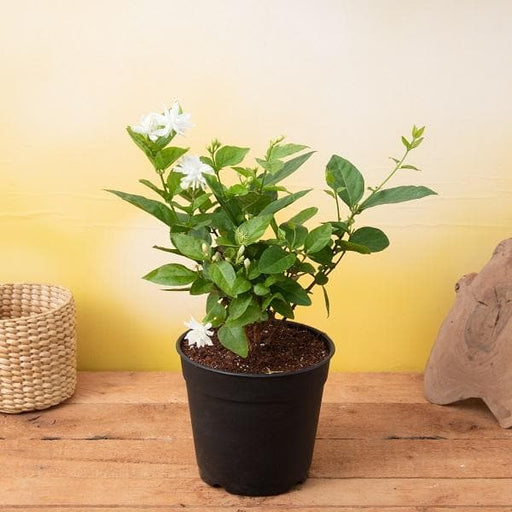
Quassia amara - Plant
(MRP Inclusive of all taxes)
- Shipping ₹79 for entire order
- Dispatch in 7 days
- Country of origin: India

(MRP Inclusive of all taxes)
 Save 29%
Save 29%
Air Purifier Money Plant with Pot The Air Purifier Money Plant, also known as Pothos or Epipremnum aureum, is a stunning indoor plant that...
View full details
 Save up to 15%
Save up to 15%
Peace Lily, Spathiphyllum - Plant The Peace Lily, scientifically known as Spathiphyllum, is a stunning houseplant celebrated for its elegant white...
View full details
 Save 25%
Save 25%
Jasminum sambac, Mogra, Arabian Jasmine - Plant Jasminum sambac, commonly known as Mogra or Arabian Jasmine, is a fragrant flowering plant...
View full details
 Save 18%
Save 18%
Combo Constituents Includes the Parijat Tree (Night-Flowering Jasmine), a culturally significant plant with fragrant flowers. Description The Pari...
View full details
 Save 25%
Save 25%
Miniature Rose, Button Rose (Any Color) - Plant The Miniature Rose, also known as the Button Rose, is a charming and compact flowering plant that ...
View full details Save 25%
Save 25%
Damascus Rose, Scented Rose (Any Color) - Plant The Damascus Rose, also known as Rosa damascena, is a timeless symbol of beauty and romanc...
View full details
 Save 17%
Save 17%
Beautiful Fragrant Mogra, Arabian Jasmine Plant with Pot The Beautiful Fragrant Mogra, also known as Arabian Jasmine (Jasminum sambac), is...
View full details Save 15%
Save 15%
Pack of Vermicompost and Neem Cake for House Plants Transform your indoor garden with our premium Pack of Vermicompost and Neem Cake, spec...
View full details
Pack of Plant Growth and Flower Boosters Unlock the full potential of your garden with our Pack of Plant Growth and Flower Boosters! This ...
View full details Save 38%
Save 38%
Combo of Jeevamrut and Neem Raksha for Easy Growth and Protection of Houseplants Transform your indoor garden with our exclusive combo of ...
View full details Save 22%
Save 22%
Plant Nutrients Kit (Pack of 16) for a Healthy Garden Transform your garden into a lush paradise with our Plant Nutrients Kit, featuring 1...
View full details Save 16%
Save 16%
Combo of Top Plant Fertilizers Elevate your gardening game with our exclusive Combo of Top Plant Fertilizers, featuring two bags of premiu...
View full details Save 24%
Save 24%
Pack of 4 Additives to Make Soil Healthy and Nutrient Rich Transform your garden into a thriving ecosystem with our Pack of 4 Additives de...
View full details Save 30%
Save 30%
Transform your gardening experience with our premium Combo of Perlite and Vermiculite. This unique blend is designed to enhance soil aeration and ...
View full details Save 27%
Save 27%
Combo of 2 Vermicompost and Cocopeat - Enrich Your Soil Naturally! Transform your garden into a thriving ecosystem with our Combo of 2 Ver...
View full details
 Save 35%
Save 35%
Best 6 Plants for Perfect Indoor Garden Transform your living space into a lush oasis with our curated collection of the Best 6 Plants for a...
View full details
 Save up to 50%
Save up to 50%
Mini Succulent Garden Pack Transform your space with our Mini Succulent Garden Pack, featuring a delightful collection of 4 any variety beautiful s...
View full details
 Save 30%
Save 30%
5 Best Fragrant Plants Transform your garden or indoor space into a fragrant paradise with our curated selection of the 5 Best Fragrant Plants. Th...
View full details
 Save 24%
Save 24%
Set of 2 Bonsai Looking Grafted Adeniums Transform your indoor or outdoor space with our exquisite Set of 2 Bonsai Looking Grafted Adenium...
View full details Save 45%
Save 45%
Top 4 Die Hard Succulents Pack Transform your indoor or outdoor space with our Top 4 Die Hard Succulents Pack, featuring a curated selecti...
View full details
 Save 30%
Save 30%
5 Best Indoor Plants Pack Transform your living space into a lush oasis with our '5 Best Indoor Plants Pack.' This carefully curated collection fe...
View full details
 Save 25%
Save 25%
Set of 4 Evergreen Air Purifier Plant Pack Transform your indoor space into a lush, green oasis with our Set of 4 Evergreen Air Purifier Pla...
View full details| SrNo | Item Name |
|---|---|
| 1 | Quassia amara - Plant |
Quassia amara, commonly known as bitter wood, is a tropical plant native to South America and the Caribbean. Renowned for its intensely bitter flavor, this plant has been utilized for centuries in traditional medicine and as a natural insect repellent. Its striking appearance, with slender branches and glossy green leaves, makes it an attractive addition to any garden or landscape.
What sets Quassia amara apart is its unique bioactive compounds, particularly quassinoids, which are known for their medicinal properties. These compounds have been studied for their potential anti-cancer, anti-inflammatory, and anti-parasitic effects, making this plant not only beautiful but also beneficial for health.
One of the special features of Quassia amara is its ability to thrive in poor soil conditions, making it an eco-friendly choice for sustainable gardening. Additionally, it attracts beneficial insects while repelling harmful pests, contributing positively to the ecosystem.
Quassia amara plays a vital role in its ecosystem by attracting pollinators and beneficial insects while deterring harmful pests. Its resilience in poor soil conditions makes it an excellent choice for sustainable gardening practices, promoting biodiversity and soil health.
Quassia amara, often dubbed the "bitter wood," is not just a pretty face in the plant kingdom. This botanical wonder boasts a plethora of health benefits, from aiding digestion to acting as a natural insect repellent. Imagine sipping a tea that not only warms your soul but also keeps pesky bugs at bay. Talk about multitasking! With its rich history in traditional medicine, Quassia amara is like that overachieving friend who always has your back, whether you need a digestive aid or a natural remedy for those annoying critters.
Cultivating Quassia amara is like hosting a garden party where the guest of honor is a low-maintenance superstar. This plant thrives in tropical climates, requiring minimal fuss and a sprinkle of sunshine. Just plant it, water it occasionally, and watch it grow into a majestic tree. It’s the perfect choice for those who want to impress their neighbors without breaking a sweat. Plus, with its striking appearance, it’s bound to be the talk of the town—or at least the garden.
The uses of Quassia amara are as diverse as a buffet at a family reunion. From traditional medicine to modern applications, this plant has something for everyone. It’s a go-to for herbalists, a secret ingredient in bitters, and even a natural pesticide. Who knew a tree could wear so many hats? Whether you’re brewing a health tonic or warding off unwanted pests, Quassia amara is the versatile sidekick you never knew you needed.
Quassia amara tea is the drink of choice for those who appreciate a little bitterness in their lives—literally! This herbal infusion packs a punch with its unique flavor profile and health benefits. Sip on this brew to aid digestion or simply to enjoy a moment of tranquility. It’s like a spa day in a cup, minus the cucumber slices on your eyes. So, brew a cup, sit back, and let the magic of Quassia amara work its wonders.
Quassia amara extract is the concentrated essence of this remarkable plant, and it’s like the espresso shot of the herbal world. Packed with potent compounds, this extract is a favorite among health enthusiasts and herbalists alike. Use it in tinctures, supplements, or even as a flavoring agent in culinary creations. Just a few drops can elevate your health game and add a touch of bitterness to your life. Who knew being healthy could taste so interesting?
When it comes to pest control, Quassia amara is the unsung hero of the garden. This plant’s natural insect-repelling properties make it a favorite among organic gardeners. Forget chemical sprays; just let Quassia amara do the heavy lifting. It’s like having a tiny army of defenders protecting your plants from unwanted guests. So, if you’re looking to keep your garden thriving without the toxic baggage, this plant is your go-to guardian.
Quassia amara has a rich history in traditional medicine, where it’s been revered for its healing properties. Used by indigenous cultures for centuries, this plant is like the wise elder of the herbal community. From treating digestive issues to acting as a tonic, its applications are as varied as the stories passed down through generations. Embrace the wisdom of the ancients and let Quassia amara guide you on your health journey.
If your stomach could talk, it would probably sing the praises of Quassia amara. This plant is a digestive powerhouse, known for its ability to soothe and support gastrointestinal health. Whether you’re dealing with bloating or just need a little help after a big meal, Quassia amara is here to save the day. It’s like having a personal digestive coach, cheering you on from the sidelines while you tackle that extra slice of pie.
Quassia amara has been making waves in the weight loss community, and for good reason. This plant is believed to help curb appetite and boost metabolism, making it a popular choice for those on a weight loss journey. It’s like having a personal trainer in your pantry, motivating you to make healthier choices. So, if you’re looking to shed a few pounds, consider adding Quassia amara to your routine—it might just be the secret weapon you’ve been searching for.
Quassia amara isn’t just a friend to your insides; it’s also a beauty guru for your skin. With its anti-inflammatory and antimicrobial properties, this plant can help soothe skin irritations and promote a healthy complexion. Think of it as nature’s skincare line, offering a gentle touch without the hefty price tag. So, if you’re looking to glow from the inside out, Quassia amara might just be your new best friend.
Quassia amara is a staple in the world of herbal remedies, and it’s not hard to see why. This plant is a treasure trove of beneficial compounds, making it a go-to for herbalists and natural health enthusiasts. From tinctures to teas, the possibilities are endless. It’s like having a Swiss Army knife in your herbal toolkit, ready to tackle whatever health challenge comes your way. So, embrace the power of Quassia amara and let it work its magic in your life.
Quassia amara, also known as bitterwood, is a tropical tree native to South America. Its bark and wood are packed with quassinoids, giving it a bitter taste. This plant is not just a pretty face; it’s a powerhouse of medicinal properties and a natural insect repellent. Bitter never looked so good!
Quassia amara is a health superstar! It’s known for its digestive benefits, helping with appetite stimulation and easing gastrointestinal issues. Plus, it’s a natural remedy for fevers and has anti-parasitic properties. Who knew something so bitter could be so sweet for your health
Using Quassia amara is as easy as pie—if pie were bitter! You can brew it into a tea, use it as a tincture, or incorporate it into herbal remedies. Just remember, moderation is key; too much bitterness can turn your health potion into a potion of regret!
While Quassia amara is generally safe, it’s not a one-size-fits-all solution. Pregnant or breastfeeding women, and those with certain medical conditions, should consult a healthcare professional before diving into the bitter goodness. Better safe than sorry, right
Quassia amara might just be your new best friend in the weight loss journey! Its appetite-suppressing properties can help you resist those late-night snack attacks. Just remember, it’s not a magic wand; combine it with a balanced diet and exercise for best results!
You can find it at health food stores, herbal shops, or online retailers. Just make sure you’re getting the real deal—no one wants a fake bitter experience!
Preparing Quassia amara is a breeze! For tea, steep the dried bark in hot water for about 10-15 minutes. For tinctures, soak the bark in alcohol for a few weeks. Just remember, the bitterness is part of the charm—embrace it!
While Quassia amara is mostly safe, it can cause some side effects like nausea or stomach upset if consumed in excess. It’s like that friend who’s fun in small doses but overwhelming in large groups. Always start small and see how your body reacts!
Absolutely! Quassia amara is a natural insect repellent, making it a green warrior in your garden. Its bitter compounds deter pests without the harsh chemicals. So, if you want to keep your plants safe and sound, this plant is your bitter ally!
You bet! Quassia amara has been a staple in traditional medicine for centuries, especially in South America. It’s been used to treat everything from digestive issues to fevers. Talk about a plant with a rich history—this one’s got stories to tell!
If you’re expecting a sweet treat, prepare for a shock! Quassia amara is famously bitter, which is why it’s often used in small doses. Think of it as the “tough love” of the plant world—great for your health, but not winning any taste awards!
Yes, you can grow Quassia amara at home, but it prefers a tropical climate. If you live in a cooler area, consider growing it in a pot and bringing it indoors during chilly months. With a little love and care, you’ll have your own bitterwood tree!